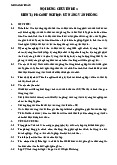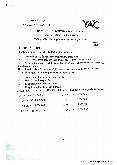



















Preview text:
Chapter 4
Completing the accounting cycle
201044 - Completing the accounting cycle Learning objectives
• Prepare an accounting worksheet
• Use the worksheet to prepare financial statements
• Close the revenue, expense and drawings accounts
• Prepare the post-closing trial balance
• Classify assets and liabilities as current or non-current
• Describe the effect of various transactions on the current ratio and the debt ratio
201044 - Completing the accounting cycle 4/6/2022 2 4.1. The accounting worksheet
• Accountants often use a worksheet to summarise data for the financial statements
• It is a summary device that helps identify the accounts that need adjustment
• The worksheet is an internal document
201044 - Completing the accounting cycle 4/6/2022 3 4.1. The accounting worksheet
• Step 1: Enter the account titles and their unadjusted balances in the
Trial balance columns of the worksheet and total the amounts
• Step 2: Enter the adjusting entries in the adjustments columns and total the amounts
• Step 3: Calculate each account’s adjusted balance by combining
the trial balance and adjustment figures. Enter each account’s
adjusted amount in the adjusted trial balance columns
201044 - Completing the accounting cycle 4/6/2022 4 4.1. The accounting worksheet
• Step 4: Draw an imaginary line above the first revenue account.
Every account above that line (assets, liabilities and equity
accounts) is copied from the adjusted trial balance to the balance sheet columns.
Every account below the line (revenues and expenses) is copied
from the adjusted trial balance to the income statement columns.
• Step 5: On the income statement, calculate profit or loss as total
revenues minus total expenses.
Enter profit (loss) as the balancing amount on the income statement.
Also enter profit (loss) as the balancing amount on the balance
sheet. Then total the financial statement columns.
201044 - Completing the accounting cycle 4/6/2022 5 4.1. The accounting worksheet • Worksheet SMART TOUCH LEARNING WORKSHEET
For the month ended 30 June 201N Accounts Trial Adjustments Adj-Trial Income Balance Balance Balance Statement sheet Debit Credit Debit Credit Debit Credit Debit Credit Debit Credit Cash Supplies Furniture …….
201044 - Completing the accounting cycle 4/6/2022 6 4.1. The accounting worksheet • Worksheet SMART TOUCH LEARNING WORKSHEET
For the month ended 30 June 201N Accounts Trial Adjustments Adj-Trial Income Balance Balance Balance Statement sheet Debit Credit Debit Credit Debit Credit Debit Credit Debit Credit Cash Supplies Furniture …….
201044 - Completing the accounting cycle 4/6/2022 7 4.1. The accounting worksheet
Ex: Continuing with the example of Smart Touch Learning. 4/6/2022 8
4.2. Completing the accounting cycle -
Preparing the financial statements from a worksheet -
Recording the adjusting entries from a worksheet
201044 - Completing the accounting cycle 4/6/2022 9 4.3. Closing the accounts
• Closing the accounts occurs at the end of the period
• It consists of journalising and posting the closing entries in order to
get the accounts ready for the next period
• It zeroes out all the revenues and all the expenses in order to
measure each period’s profit separately from all other periods and
updates the Capital account balance
201044 - Completing the accounting cycle 4/6/2022 10 4.3. Closing the accounts Temporary accounts Permanent accounts
Closed at the end of the period Not closed at the end of the period Examples include Revenues, Examples include Assets, Expenses, Drawings Liabilities, Capital Start next period with a zero
Ending balance carries forward to balance next period
201044 - Completing the accounting cycle 4/6/2022 11 4.3. Closing the accounts
• Step 1: Make the revenue accounts equal zero via the Income summary account
• Step 2: Make expense accounts equal zero via the Income summary account
• Step 3: Make the Income summary account equal zero via the Capital account
• Step 4: Make the Drawings account equal zero via the Capital account
201044 - Completing the accounting cycle 4/6/2022 12 4.3. Closing the accounts
201044 - Completing the accounting cycle 4/6/2022 13 4.3. Closing the accounts
Ex: Prepare the closing entries and post to the T-
accounts for Smart Touch Learning. 4/6/2022 14
4.4. Post-closing trial balance
• The accounting cycle can end with a post-closing trial balance
• This optional step lists the accounts and their adjusted balances after closing
• Only assets, liabilities and capital accounts appear on the post- closing trial balance
• No temporary accounts are included (revenues, expenses, drawings)
201044 - Completing the accounting cycle 4/6/2022 15
4.4. Post-closing trial balance
201044 - Completing the accounting cycle 4/6/2022 16
4.5. Classifying assets and liabilities
• Assets and liabilities are usually classified in balance sheets as either current or noncurrent
• Under each heading it is also usual to list assets and liabilities in order of decreasing liquidity
• Liquidity is a measure of how quickly an item can be converted to cash
• An alternative balance sheet format is to list assets and liabilities in
order of decreasing liquidity without the division into current and non-current assets.
(AASB 101, Presentation of Financial Statements)
201044 - Completing the accounting cycle 4/6/2022 17
4.5. Classifying assets and liabilities Assets
• Current assets are assets that are expected to be converted to
cash, sold or consumed during the next 12 months, or within the
business operating cycle if longer than a year
• The operating cycle is the time span during which (1) cash is used
to acquire goods and services, and (2) these goods and services
are sold to customers, from whom (3) the business collects cash
• Non-current assets are all assets other than current assets
201044 - Completing the accounting cycle 4/6/2022 18
4.5. Classifying assets and liabilities Liabilities
• Current liabilities are debts that are due to be paid with cash or with
goods and services within one year, or within the business operating cycle if longer than a year
• All liabilities that aren’t current are classified as non-current liabilities
201044 - Completing the accounting cycle 4/6/2022 19
4.5. Classifying assets and liabilities The classified balance sheet
201044 - Completing the accounting cycle 4/6/2022 20




